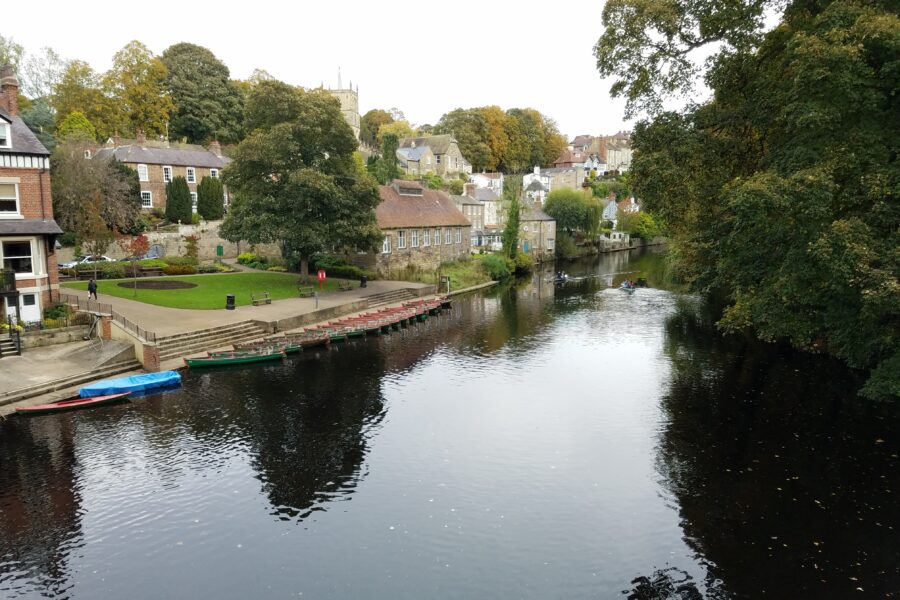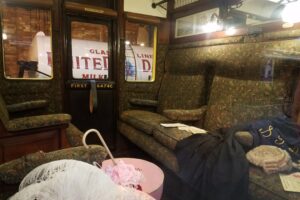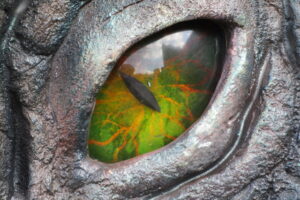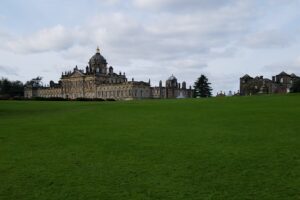So back to the map I go. Searching. I choose Harrogate—the name sounds familiar. Maybe I’m confusing it with Harrods in London. Then I notice Knaresborough and see they have a castle, a river, unusual rock formations, rowboats for rent, gardens, and Mother Shipton’s Cave—a tourist attraction since 1630. I yell at Michael that we are going to Knaresborough and having lunch at The Guy Fawkes Arms in Scotton. “Whatever you want to do Charlotte.”
It seems rather complicated, but I am sure it will work out.
The predicted sunny day, isn’t. But plans are made, so we make our way to the car, passing a church that is still a church—not a night club or a stained glass center—with a charming blue door. I stop to take pictures and read the signs. Russian Orthodox.


Ubiquitous gray skies over Yorkshire.
Within minutes of leaving York we are in the country with all of its sights and smells—the smells are pervasive. Seldom have we had smells this penetrating accompany us down the road. We notice the land around us is not green grassy pastures for grazing sheep, but furrowed rows of plowed earth. In front of us, a farmer inches onto the road with his tractor. Michael suggests that maybe he is fertilizing his fields—it smells very plausible.
Knaresborough is rather cute, but much bigger than I imagined, not a village, but a full blown town. No easy parking. No quick jaunt. My analytical mind does some quick projections. Noon is barely an hour away.
“Let’s take a walk through Harrogate, have lunch, and then come back here and explore.”
We sail through Knaresborough nosing the car down the A road toward Harrogate. After several abortive efforts we find a car park, squeezing the car into a too narrow space. At the moment Harrogate doesn’t excite me, but as we walk, I’m hooked. It’s clean, beautiful and breathable. Wide avenues. Beckoning shops. Beckoning gardens.

However, the gardens only beckon. “Do you see how far down that hill they are?” Michael asks. Surely there is an easier way, but Michael walks quickly past their beckoning lure. I follow.

Scotton is as cute as I imagined, and pulling into the parking lot of the inn I am looking forward to a cozy English pub style lunch. A centenarian pulls in beside us, asking Michael if the inn is open for lunch. He runs off to check it out. I can’t understand why, their website says they are open seven days a week. I stand at the car wondering why he didn’t lock it. Returning, he tells the individuals of all three cars waiting in the car park that it is closed on Tuesday’s in October.
Not wanting lunch in a town or a city, but a village, I suggest Spofforth as an alternative. “It’s not far. They have a castle and two pubs. And it’s only a few miles south of Knaresboro.” Bless his heart, he’s flexible.
The exterior of the Castle Inn is cute and old and warm and wonderful. The interior dining room is light and airy and modern—not exactly what I was looking for, but I’m flexible too. The wait staff and the cook are in no hurry. I have sweet potato curry, and because I am still hungry I add dessert and cappuccino to my calorie count. Almost three hours later we leave to check out the castle.

Closer to the inn than we realize, we bypass the entrance and are halfway to Knaresborough before back tracking down the small country road. The castle is a ruin—a ruined ruin; crumbling under its weight in the damp, never drying air. It is green with decay, hiding well its secrets of former glory.

I discover that William de Percy, owner and builder of the castle, is a Norman nobleman who arrived in England immediately after the Norman Conquest of 1066, granted this land by William the Conqueror. Spofforth became his home and family headquarters for 200 years. His wealth helped to finance the building of Whitby Abbey and as my memory goes back to historical novels I read, I recall the name Percy appearing over and over again in the War of the Roses.
We are virtually alone with the ages except for a young father and his two very young sons who run and climb and play pretend. The father joins in the adventure of slaying dragons and finding the lost princess. I wish I were a fly on the wall and could watch unobserved. The wonder and imaginings of childhood are treasures. These little boys are innocent jewels.

With the day spent we drive back to Knaresboro, leaving the Toyota in a car park adjacent to the River Nidd and are given a glimpse of what we missed. I want to be on that river in that rowboat. If only I were two people. Had more time. I hope we’ll be back.
Harrogate
A Victorian spa town and rural district that contains the medieval city of Ripon, a designated Area of Outstanding Natural Beauty and four charming but very different market towns; Boroughbridge, Knaresborough, Masham and Pateley Bridge
Knaresboro
A small town full of surprises, a warren of medieval streets and stone staircases that weave their way up and down the hill. The town centre is perched on the cliffs above the River Nidd and the railway viaduct across the Nidd Gorge offers an amazing view to visitors if they arrive by train.





















Leave a Reply
Your email is safe with us.